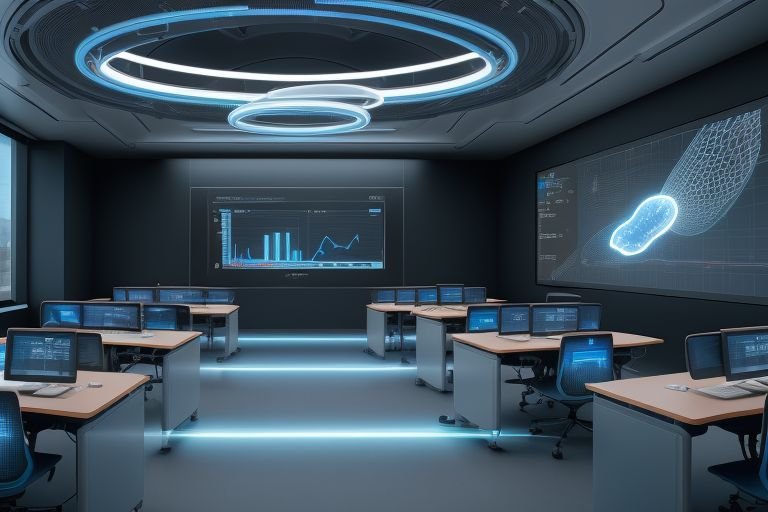
Brain-Cloud Sync Technology Reshapes Global Education by 2029
A breakthrough technology with the potential to change the way information is accessed and shared worldwide has emerged. Brain-cloud sync systems, anticipated by 2029, introduce direct connections between the human brain and large digital libraries, ensuring that learners receive information immediately.
Recognition of this innovation will totally redefine the teaching and learning process and will, above all, make the knowledge already gained widely available in the world through the power of thought.
Apart from being light and comfortable, such non-invasive neural interfaces fulfill the function of a link between the human brain and knowledge stored in the cloud.
Furthermore, these gadgets transform electronic information into signals that can be put to the human brain, which allows the individuals to understand even complicated subjects in a fraction of a second. It’s seamless for knowledge to quickly move into one’s mind from the fields of quantum physics through to ancient history.
The shown technology gets rid of issues that are traditional in education, for instance, the high cost that comes with institutions and limits set by geography. It’s not beyond the bounds of possibility that a farmer from a faraway place can be an expert in the field of engineering, or that a town moviegoer can acquire knowledge in advanced biology without needing to read a book. The chance to bring the poorest communities in the world to a higher plane of living is massive, and, as a result, the globalization of equality is allowed.
Classrooms as of 2029 are now a setting where students, as a group, are supposed to work their way through the information with the help of neural networks. Instead of traditional lecturing, teachers accompany students and facilitate critical thinking. The change in the education system emphasizes the importance of creativity and problem-solving first and foremost, as the information is readily available to everyone with no delay.
New jobs have been created, and a strong impact on the economy has been noticed. Given that employment is aiming at a workforce that is only advanced in skills, this has then led to increased learning through the neural network.
Certifications that confirm proficiency in neural skills are now prioritized. The new evaluation method is achieved during cloud-based learning, thus manifesting real-life experiences. It is expected that the expansion will continue and ultimately touch the sectors of healthcare, technology, renewable energy, and other services.
And still, some challenges remain unaddressed as people all over the world are trying to get their heads around ethical complications. Worries that have to do with the safety and privacy of personal data emerge as the means of neural interfaces to go through someone’s thoughts take place. To protect mental autonomy and maintain a flow of knowledge without obstacles, governments and technological companies make joint efforts to achieve this.
It is evident that access to resources is crucial for the development of one’s skills. Thus, global endeavors take place all over the world, with neural device accessibility as an integral point, to bring low-income regions on board. By 2029, people living in billions of low-income areas will have access, thus closing the education gap.
Through this massive scale of learning, communities actually take charge of changing the situation rather than waiting for it to change first, through cooperative expertise as they share.
Furthermore, the technology in question brings changes to the concept of learning throughout one’s life. People of adult age not only possess a set of required skills that are related to a specific job, but they are also in a position to add new skills for jobs that are evolving.
For instance, a factory worker might earmark the next several days to become a robotics expert anyhow and also adjust to the rise of automation. This, of course, becomes a basis for economic performance to rely on, and hence it calls for the need for fewer people to be unemployed in the economy in which they are.
The point to be highlighted is the cultural exchange expansion upon the easy access of global viewpoints through the human brain. Interactions with the web of neural downloads boost cross-cultural and linguistic understanding.
With the help of interconnectedness, partnerships between different countries emerge; knowledge plays the role of the bridge that bridges people’s divisions, which were built by ignorance.
On the other hand, a large dependence on brain-cloud sync may crush the human spirit of thinking over and might have counter-effects like cognitive independence. The critics of such practice argue that learners who grasp the materials presented to them instantly, and without much difficulty, may drop their ability for thorough and thoughtful analysis.
Thus, to alleviate the current situation, educators promote and stress the need for a mixed curriculum consisting of traditional exercises and the latest technological trends.
The environmental effect of this technology is an important issue. Data centers, which are running learning in the cloud, consume a large amount of energy. That is why investments are being made in the renewable energy supply. The world’s education expansion perfectly corresponds to the worldwide renewable energy sources – 100 % of the servers concentrated by 2029 will be generated by solar and wind power.
The dynamics in society change when knowledge is the universal currency. The traditional social status, which is formed by the lack of access to education, is falling apart, and it not only empowers people but also gives them the possibility to confront the rigid power structures. The grassroots get the benefit of neural help to voice out their opinions on going from equity to resource sharing, and finally, the governance model, which is geared to be all-inclusive.
The consequences in psychology are deeply felt, and it is immediate learning that alters the perception of the self that causes it. People who couldn’t make it despite their social circumstances are the ones who have most discovered they can still do anything. This awareness has led to their trying to take advantage of their potential in business, most notably, and many startups have been created, which are from areas that were globally overlooked in the past.
During technology’s journey in 2029, it gets in touch with reality virtually through the AR mode, and so it upgrades learning through the role played by real experiences. In this way, students can go into a virtual world for the exploration of different types of ecosystems or instances in history that seem to them like those really happening; of course, this will enable them to learn thoroughly.
In addition, the students’ use of various senses transforms concepts initially having an abstract nature into tangible ones, hence leading to the kind of learning that is the reason for disciplines like natural science and anthropology being revolutionized.
It has been a great era in the world of academia by means of the new method of learning called neural communications, which has succeeded in making the transfer of knowledge and ideas from one expert to another a matter of split seconds, thereby accelerating the speed of global scientific community collaboration.
This collective wisdom has led to the discovery of innovative solutions in medicine and has boosted the renewable energy sector, which is currently being threatened. The prospects of humanity’s capability to combat the challenges of climate change through our newfound speed of getting pooled knowledge together cannot be underrated since, indeed, this world is the new focus of the universe’s concerns.
Once its viability was understood, the introduction of such a technology immediately faced opposition from those who believed certain elements of their culture would be lost. These people claim that the process of instant learning eliminates the need for slow but orderly studying of the culture, and at the same time creates the risk of cultural degradation.
The other side suggests that the technology protects the culture from fading away, as it gives everyone instant access to the history of the world, and in that way, the interest in the national heritage becomes stronger.
Legal framework advances as part of the change in the field of neural property rights. It is as if one brain registers itself with a cloud server, and then the question arises: how does this kind of thing work in terms of the personality and properties of the brains involved? It is precisely at this time that new global standards are drawn up. Total innovation is achieved by a careful balance between end-users, who are the actual owners of products, and developers, who utilize global stock knowledge without losing sight of their one-time endeavor.
At this point in time, brain-cloud synchronization is responsible for the revolution in the capabilities of a human being who, at birth, gets the right to education as a personal resource and not a societal privilege. These consequent changes reach out to different parts of society, economic, and sub-cultural units of society, thereby serving as evidence that widespread knowledge-sharing and cooperation between many parties are the driving factors for societal change.


